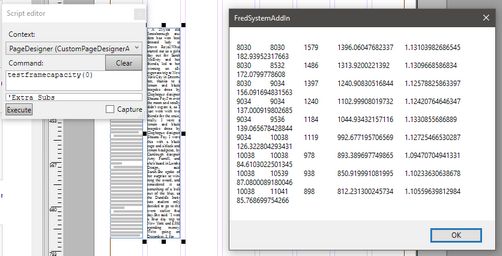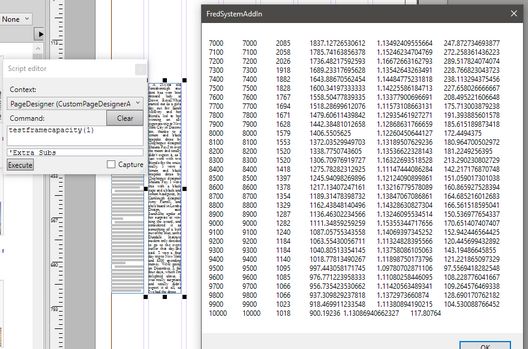Using TestFrameCapacity to get coefficients to improve the estimate precision
The software contains an auxiliary function to get coefficients to improve the estimate precision. You can perform the test on a frame varying its dimensions. The function uses the text as explained in the Customizing text used for the shape measuring topic.
The function name is TestFrameCapacity and you can call it from the Fred4 Script Editor.
Work modes
There are three modes of work
TestFrameCapacity(0)
It displays the coefficient and other values for 9 frequently used combinations. On the following screenshot, the values used for type size and leading 8pt/8pt, 8pt/8.5pt, 8pt/9pt, 9pt/9pt, 9pt/9.5pt, 9pt/10pt, 10pt/10pt, 10pt/10.5pt, 10pt/11pt. The mpt values are larger, because the system where the screenshot was taken uses Big Points, and therefore, the millipoints have the greater values.
The six returned values are (reading from the second row):
- type size in mpt: 8030
- leading in mpt: 8532
- number of characters read in the sample text: 1486
- number of estimated characters, calculation based: 1313.92
- coefficient to apply on the estimated characters to bring them close to the real characters: 1.13096
TestFrameCapacity(1)
It displays the coefficient and other values for the range from 7pt to 10pt, in increments of 0.1pt. The leading is the same as the type size. The six returned values have the same structure as explained in the previous paragraph.
TestFrameCapacity(2)
It displays the coefficient and other values for the range from 7pt to 10pt, in increments of 0.1pt. The leading is the same as the type size increased for 500mpt. The six returned values have the same structure as explained in the previous paragraph.
TestFrameCapacity(3)
It displays the coefficient and other values for the range from 7pt to 10pt, in increments of 0.1pt. The leading is smaller than the type size for 0.967742. The six returned values have the same structure as explained in the previous paragraph.
Customizing TestFrameCapacity function
You can create an override for this function in your CUSTOMPAGE.VB and then redefine all the ranges.


